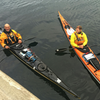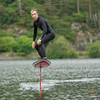Find Your Perfect Wetsuit: Key Things To Consider

Over the years at Snowdonia Watersports, we have fit a fair few wetsuits. Big ones, small ones, back zip, front zip and everything in between. We have worn a fair few of these sweaty skin-tight suits in our time too. So in this month's blog, we are going to discuss the humble wetsuit. What do you need to consider and which suit might be right for you?
The wetsuit is an essential bit of kit for any water sports enthusiast, whether surfing, swimming, kayaking, SUPing or any other water activity requiring prolonged exposure to cold water. However, with so many types and varieties of wetsuits available in the market, it can be challenging to know which one is right for you. In this blog post, we'll discuss the critical factors to consider when buying a wetsuit, including the type of neoprene, the thickness, and the different types of stitching.
Type of neoprene:
Neoprene is the primary material used to make wetsuits, and it is essential to know the different types of neoprene available in the market. The most common types of neoprene are Standard Neoprene, Super-Stretch Neoprene, and TechnoButter Neoprene. Standard neoprene is the most affordable and widely used type of neoprene. It is durable, but not as flexible as Super-Stretch Neoprene, which is more expensive but provides greater flexibility and comfort. TechnoButter Neoprene is the most advanced neoprene available in the market, with excellent stretch, durability, and insulation properties.
Thickness:
The thickness of a wetsuit is another critical factor to consider when buying a wetsuit. The thickness of a wetsuit is measured in millimetres, and it ranges from 1mm to 7mm. The thicker the wetsuit, the more insulation it provides, but the less flexibility it offers. A 3mm wetsuit is ideal for warmer water conditions, while a 5mm or 7mm wetsuit is best for colder water temperatures.

Stitching:
Stitching is another crucial factor to consider when buying a wetsuit. There are two primary types of stitching that we sell: Flatlock Stitching and Glued and Blind Stitching. Flatlock Stitching is the most common type of stitching and is suitable for wetsuits used in warm water conditions. Glued and Blind Stitching is ideal for wetsuits used in colder water temperatures as it offers excellent insulation properties.


Zip Placement:
Where the zip is placed can make a big difference. The back zip is more common with cheaper wetsuits and is one of the more popular closures. These wetsuits tend to be easier to get on and are found in every discipline that involves a wetsuit. The chest zip is another popular variation, this style is perfect for use in the surf and dynamic environments as it allows for maximum movement and flexibility. It will prevent flushing if a large wave rolls over you but can be difficult to get on, especially if you happen to have very long hair, a big tummy or a large chest.

Sport / Time of year:
It's important to pick the appropriate wetsuit for your sport. If you're going to be messing around in cold water, then a thicker wetsuit is necessary to keep you warm. A 5mm+ suit will help you stay comfortable. Hence why they are called winter wetsuits.
On the other hand, if you plan on doing your sport during the summer, a thinner wetsuit would be better suited for the task. A thinner 3/2mm suit allows for more movement and is less hot than a full winter wetsuit. If you are somewhere in between, then a Spring wetsuit of 4/3mm would work just fine.
A suit with a glide skin feature is ideal for you open water swimmers out there. This material helps you move through the water with less resistance, which is particularly important when swimming long distances. One potential downside is that it can be quite fragile material, so this wetsuit would purely be for swimming.
Overall, choosing the right wetsuit for your activity is essential for ensuring maximum comfort and warmth. Take the time to consider the type of neoprene, the thickness, and the different types of stitching to make the best choice for your needs. Don't forget to think about the specific demands of your sport and choose a suit that will help you perform at your best.
-
Posted in
advice, cold water, neoprene, openwater, paddleboard, paddleboarding, surfing, swimming, watersports, wetsuit, winter




